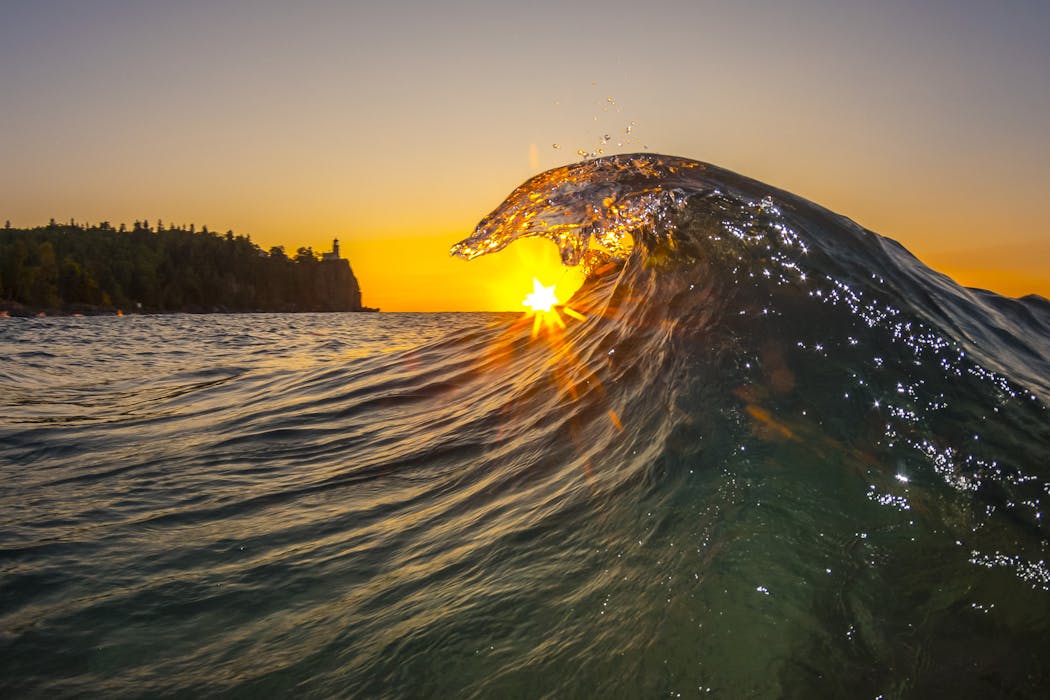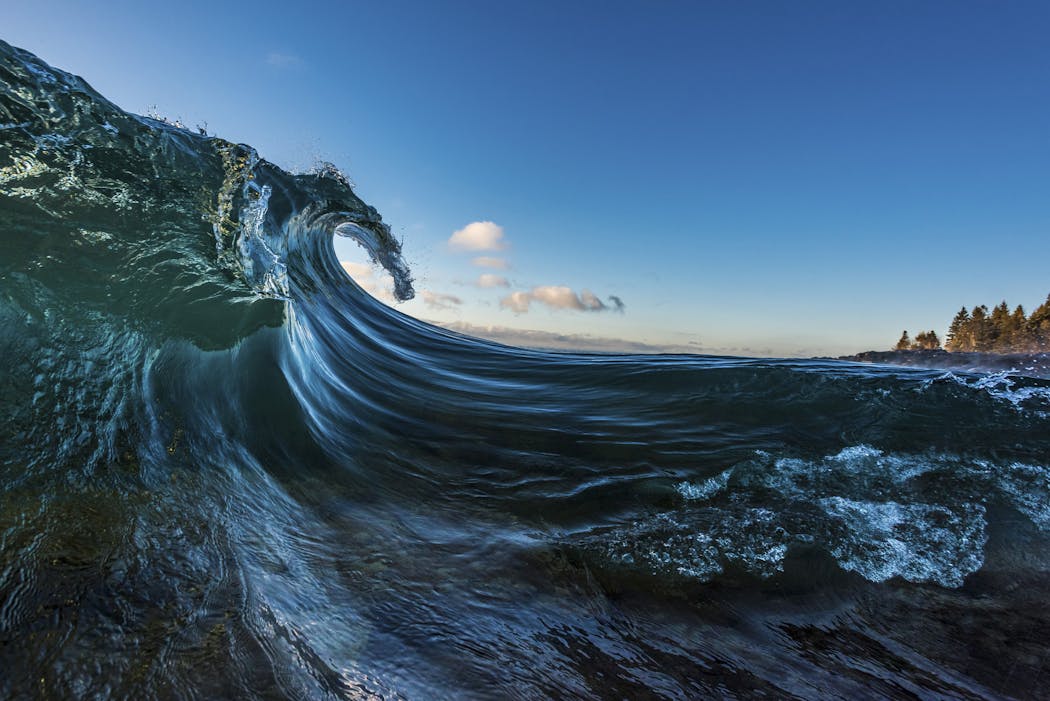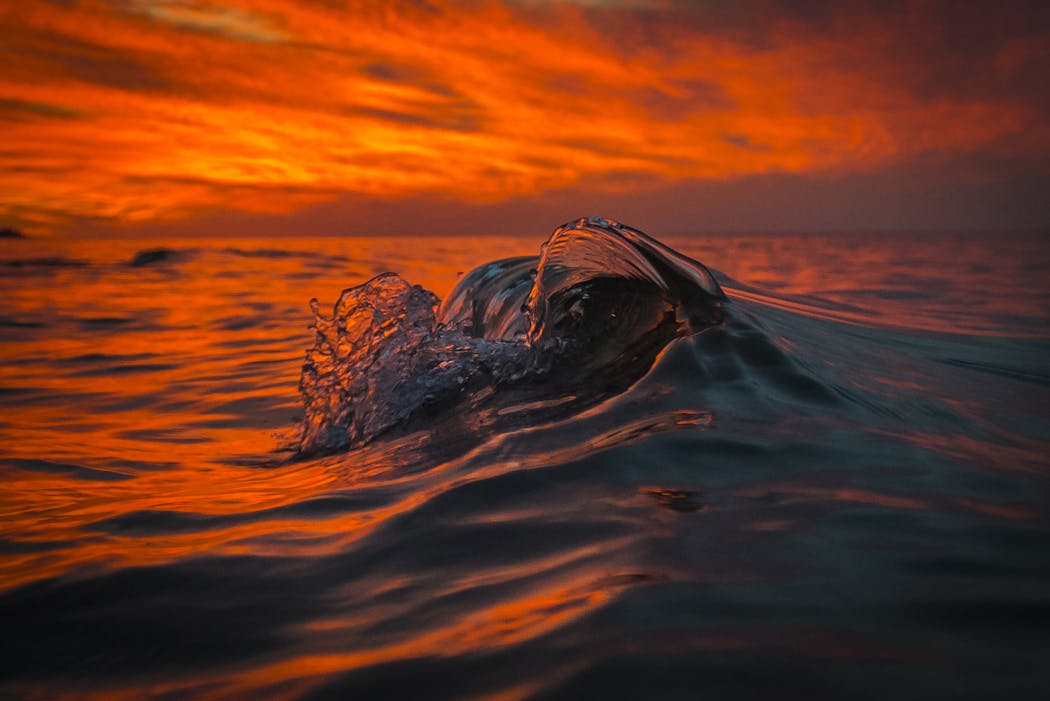Anyone who's traveled to the North Shore has probably taken a picture of Lake Superior. But how many people have taken pictures in Lake Superior, even in winter?
Probably only Christian Dalbec of Two Harbors, Minn., a man who's obsessed with diving in to capture photos from the water's surface.
Year round, regardless of cold weather or colder water, he climbs into a wet suit, snorkel, fins and mask and swims out, clutching a camera in a waterproof housing. Once he paddles off from shore, he takes photos of surfers and shipwrecks, sunsets and sunrises, lighthouses and waves — hundreds and hundreds of waves — all from the point of view that has been seen only by Lake Superior fish.
He's carving out a niche as a professional photographer (christiandalbecphotography.com), with his images landing on the covers of magazines, being displayed in local businesses, getting published in calendars and being sold in art galleries.
Surf photographers have been taking beautiful ocean wave pictures for years in places such as Hawaii and Australia. But there's a reason why few have done it on the greatest of the Great Lakes: It's difficult, risky work.
Usually Dalbec is out there alone, on the coldest days of the year, swimming in often turbulent water. (That's how you get the wave pictures.)
People watching from shore sometimes call to him, asking if he needs help. But for Dalbec, a youthful-looking 50-year-old, taking pictures in the dangerous waters of the lake has been a life saver.
For most of his life, he was an alcoholic, wasting his time in bars, getting into trouble with the law and accumulating drunken driving arrests. He was slowly drinking himself to death until the day he put down the bottle, picked up a camera and got in the lake. He found a new profession as a surf photographer. And getting wet helped him get dry.
"The photography became my passion, and I guess, my new addiction," he said. "I got sober with the camera."
Living in the bar
It's 5 in the morning. It's cold and dark as Dalbec turns on the heat in the camper sitting on the back of his 1998 Chevy pickup truck and loads it up with his gear. He wants to drive the 19 miles up Hwy. 61 to Split Rock Lighthouse State Park and be there an hour before dawn.
It's a trip he's made countless times, sometimes twice in a day to catch the sunrise and the sunset. The golden light of dawn on the water, with the lighthouse in the background, can result in an image worth hundreds of dollars.
"I basically go to Split Rock every day," he said. "The lighthouse is pretty popular. That will sell the shot."
Dalbec has lived all his life on the lake. He was born in the Twin Cities, but was adopted and raised by a Two Harbors family. He's never met his birth parents.
He got married out of high school and worked at a waferboard siding plant in Two Harbors. He also did carpentry work and worked with his father's blacktop business. For a while, he worked for a company that rents instruments and gear for touring bands and was himself in a band, hoping to be a rock star. He got divorced. He has three kids.
The one constant was drinking. He started when he was about 15. He was caught driving drunk as a teenager and a couple more times as an adult. To avoid another arrest, he would walk to the bars in Two Harbors, where he spent his days. He'd go home to nap, then head back to the bar so he could drink some more.
"So that's like getting drunk two or three times a day," he said. "I remember every day sitting there, going, 'I've got to get out of this position.' But also thinking, 'There's no way out. I don't know how to do it.' I'm 40-some years old and just been in trouble my entire life."
Then in 2011, he got arrested for drunken driving for the fourth time. He was convicted of a gross misdemeanor and was ordered into an alcohol treatment program. He was sentenced to 30 days of wearing an electronic ankle bracelet.
Unable to drink, he picked up the entry-level Nikon camera he had bought a while back with money he got from selling his dirt bike after a motorcycle accident. Unable to drive, he walked around town looking for something to shoot.
"I would just go around Two Harbors Point and try to get something different every day," he said. "The lake was right in my backyard. I never paid attention to it before."
He went to AA meetings in town, but he found his attention straying to the sunset over the water that he wanted to photograph.
"I think my AA is being out at the lake," he said. "I can see the shots. I always said, 'Man, if I had a camera.' "
John Gregor, a professional photographer and photography teacher from Two Harbors, met Dalbec in a bar.
"He was interested in photography, but he was always telling me about what he was going to do," Gregor said.
After his last arrest, Dalbec attended a workshop that Gregor taught at the library, then began taking pictures in earnest.
"He went from talking about what he was going to do and going out to do it," Gregor said. "I like to say I showed him which buttons to push and he took it from there."
Dalbec started by taking pictures of the lake from the shore, but he wondered if he could take photos in the water like surf photographers in other parts of the world. "I want my audience to say, 'Where is he shooting from?' " he said.
But a specialized waterproof housing that would protect his Nikon camera while still allowing him to shoot with manually adjusted settings cost thousands of dollars.
He decided to test the idea with the gear he had, getting into the lake at Duluth with an old two-piece wet suit and a GoPro camera. He took a picture of a wave with the Aerial Lift Bridge in the background.
"Wow, that's cool," he thought of the results. "I've got to get this with a real camera."
He decided he would buy that expensive waterproof housing after all. And a better wet suit.
The three sisters
The trailhead parking lot at Split Rock is empty when Dalbec pulls in. At the entrance, he pauses in the dark and makes the "shaka" hang loose sign with his hand.
It's a ritual he does every time he's about to get into the water. "Here's to safety and good luck," he says.
He may need it.
"You'd better believe it's dangerous," said Erik Wilkie, a Lake Superior surfer from Wisconsin. "There's no lifeguards, no second chances."
The water is cold, and the currents can be wicked, said Wilkie, who runs a Facebook page that sometimes posts Dalbec's surfing photos. Unlike surfers, Dalbec is swimming. He's not riding a buoyant surfboard that will keep him afloat.
"He doesn't have the safety equipment the rest of us do," Wilkie said. "He's out there by himself."
Dalbec's closest call came when he wanted to get a close-up picture of a curling wave on a high-surf day.
"This is where I had already been in some waves and I thought I knew what I was doing," he said. He swam out, ignoring a surfer who shook his head and said, "Don't do that" as he went by.
He was slammed by a succession of waves that the lake fishermen call "the three sisters."
"It took me into — they call it the washing machine — inside the wave. That rolled me for a while. I was underwater, spinning, holding my breath. I remember not knowing what to do," he said.
He eventually surfaced and made it to shore, carrying only one fin. The other was torn off and lost in the lake. The incident shook him.
"I didn't think I was ever going to get in the water again," he said.
But he studied YouTube videos, learning how surfers dive beneath breaking waves to avoid danger. He started wearing a weight belt to control his buoyancy and taught himself to hold his breath longer. He also started wearing a helmet to protect himself from an errant surfboard or a chunk of ice.
Dalbec, who got remarried last year, has a ritual when he gets out of the water. He makes a cup of coffee in his camper and sends a text to his wife telling her that he's safe on land.
Not afraid of the cold
The sun is just about to rise when Dalbec walks to the shore in his wet suit and gets into the water near the lighthouse.
It's mid-March and the air temperature is a few degrees below freezing, the water temperature a few degrees above. The surface is calm. It's practically a day at the beach compared with some of the days Dalbec has gone in.
"I mainly want to be in rough water," he said. "There's a lot of just blind shooting and guessing when you're in the water and you're being tossed around."
His aim is to use his camera to catch a fleeting combination of water and light and motion that will never come again.
"I guess I'm always looking for that next really cool wave in the water," he said.
If the water near the shore isn't iced over, he gets into Lake Superior about five days a week. He went in at Split Rock on Jan. 30 when the air temperature was 27 below, posting a picture of himself on Instagram with ice stuck to his helmet.
By the time he got out of the water that day, the zipper on his wet suit was frozen and his hands had stopped working. He had to set his camera on the ground in the parking lot and run into a park building to warm up, using his feet to step on his neoprene lobster mitt gloves so he could yank them off.
No wonder Dalbec is one of the few — if not the only — to take these kinds of pictures in Lake Superior.
"It's not the easiest kind of photography," he said. "People are afraid of the cold. They're afraid of it in the summer. Anytime it's Lake Superior, people are afraid of getting into it."
In his short time as a professional photographer, Dalbec has swum into sea caves at Tettegouche State Park, around shipwrecks at Grand Marais and beneath the Witch Tree near Grand Portage. He's traveled around the country to take water pictures: in the ocean in Hawaii, in a river at Zion National Park, in a lake at Grand Teton.
But it's his pictures of Lake Superior that caught the attention of Jan Sivertson, owner of Sivertson Gallery in Grand Marais. She recently started selling Dalbec's images in her gallery. They're printed on sheets of metal, with the big 24-by-36-inch ones going for $1,200.
"I'm sitting next to [famed nature photographer] Jim Brandenburg" in the gallery, said Dalbec, who is building his own small gallery in his garage in Two Harbors. "That's kind of cool."
Sivertson said Dalbec's close-up photos of Lake Superior waves are an intimate, rarely seen view of the giant body of water. "He captures the essence that hardly anyone sees," she said.
Professional photographer Gregor agreed.
"He's definitely got something that if it's not unique, it's very rare," Gregor said. "How on earth did he get that shot? Well, he got it because he got in that lake."

Trail section at one of Minnesota's most iconic spots closing for rehab

Will 'shotgun only' zone for deer in southern Minnesota be abolished?

Four Minnesotans catch salmonella in outbreak linked to basil sold at Trader Joe's






